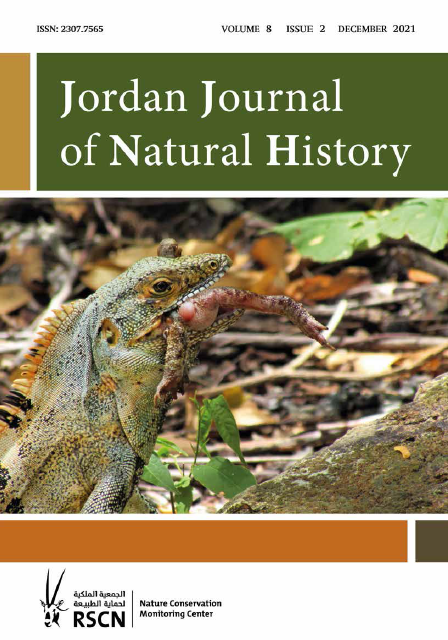Articles
New Records for the Native Flora of the West Bank, the Occupied Palestinian Territories
Author Name
Banan Al-Sheikh and Mazin B. Qumsiyeh
Thirteen species which belong to eight families of vascular plants are hereby reported as new and noteworthy records from the Occupied Palestinian Territories in the West Bank. While reported elsewhere in Palestine, many provide range extensions southwards and it is relevant to report them here especially that Palestine is now recognized as a state within the 1967 borders (West Bank and Gaza) and as this can be helpful for planning purposes. These include Alisma plantago-aquatica L., Damasonium alisma Miller, Butomus umbellatus L., Lactuca aculeata Boiss. & Kotschy ex Boiss, Scorzonera phaeopappa (Boiss.) Boiss., Convolvulus scammonia L.., Convolvulus coelesyriacus Boiss., Stachys distans Benth., Salvia sclarea L., Securigera parviflora (Desv.) Lassen, Crypsis acuminata Trin., Crypsis alopecuroides (Piller et Mitterpol) Schrader, and Pteris vittata L. Much more work remains to be done to add to the growing list of the flora of this region.
The Consumption of Dead Incilius luetkenii (Anura: Buffonidae) by Ctenosaura similis (Squamata: Iguanidae)
Author Name
Lucía I. López and José Manuel Mora
The Ctenosaur or Black Iguana (Ctenosaura similis) occupies xeric habitats in Mesoamerica from southern México to Panamá. Juvenile individuals consume mainly invertebrates, but they present an ontogenic change to herbivory as adults. Moreover, the species is highly omnivorous and consumes several types of organisms including young Ctenosaurs. However, the consumption of carrion is rare in this species with only one case of consuming a giant toad (Rhinella horribilis) reported. The current study reports the consumption of a dead Yellow Toad (Incilius luetkenii) by a young adult Ctenosaur at the dry forest of northwestern Costa Rica. This toad species is common in the dry forest of Santa Rosa National Park where it breeds explosively at the beginning of the rainy season. At this time, several individuals are killed by cars while crossing the roads, and the young adult Ctenosaur, it seems, took advantage of this situation for an easy meal.
Morphological and Anatomical Studies on Buchholzia coriacea Engl. (Capparaceae) Endemic to West Africa
Author Name
Ekeke Chimezie, Ariwaodo Joseph, and Eric Esther Enwongo-Abasi
Morpho-anatomical and distributional studies of Buchholzia coriacea Engl., an endemic species to West Africa, were conducted based on herbaria and fresh samples using physical observation and microtomy. This species is hypostomatic with anomocytic and tetracytic stomata in random distribution on the abaxial surface, and is covered by non glandular hairs. The subsidiary cells are distinct, epidermal cells polygonal in shape, and the anticlinal walls straight or curved. Abaxial epidermal cells measured 4.139 ± 1.28 μm long and 2.21 ± 0.39 μm wide and the adaxial ones 4.52 ± 0.59 μm long, and 2.74 ± 0.34 μm wide. Guard cells are often equal in size, oval, and with abaxial stomatal index (SI) 36.36. The mesophyll comprised spongy and palisade mesophylls. The palisade parenchyma cells are arranged in rows of 2-3 layers, while the palisade parenchyma cells have 7-8 layers with many intercellular air spaces and a bundle sheath embedded in them. Sclereids and fibre cells occurred in a discontinuous ring outside the secondary phloem. Buchholzia coriacea exhibited a latitudinal distribution across the transitional equatorial region of Nigeria which suggests that it is confined to the tropical areas and may not thrive in drier parts. Currently, its conservation status remains unknown and has not been assessed by the IUCN. Therefore, its sustainable collection and use are of paramount importance not only to the Nigerian society, but also to the world at large mainly to face the global climate change resulting from human anthropogenic activities and also because of the medicinal properties of this species.
The Reproductive Ecology of Asystatia gangetica (L.) T. Anderson (Acanthaceae)
Author Name
Divya Sree Mocharla and Jacob Solomon Raju Aluri
Asystasia gangetica is represented by two subspecies in the study area alba and micrantha ofwhichtheformeristhemostcommon, and the latter is very rare. It is hermaphroditic, prominently protandrous, self compatible, self-pollinating, facultatively xenogamous, melittophilous but also psychophilous. Floral rewards for pollinators include nectar and pollen, both with several essential and non-essential amino acids and proteins. The fruit and seed characteristics enable the plant to produce several batches of plants in the same growing season. The dual modes of reproduction and the flexible facultative xenogamous mating system ensure the plant’sformation of huge populations within a short period of time even in the absence of its pollinators and sustains it as a successful invasive weed.
Phytodiversity and Morpho-Ecological Features of the Plants of the Tirah Valley, Khyber District, Pakistan
Author Name
Asad Khan, Lal Badshah, Farrukh Hussain, Khalid Aziz, Ghulam Jelani and Wahid Hussain
The first phytodiversity ever analyzed during 2015-2016 revealed 330 species (sp) and 230 genera (G) of seventy-eight families in the Tirah Valley, Khyber District, Pakistan. The dicots had 277 species, 188 genera, and sixtyone families. Monocots shared thirty-five species with twenty-five genera of nine families. Bryophytes, pteridophytes and gymnosperms, respectively contributed two, ten and six species. The leading families were Asteraceae (30 sp; 24 G), Lamiaceae (28 sp; 19 G), Rosaceae (27 sp; 13 G), Poaceae (19 sp; 15 G), Brassicaceae (15 sp; 10 G), Solanaceae (13 sp; 7 G), Cucurbitaceae (12 sp; 7 G), and Papilionaceae (11 sp; 8 G). The remaining families had fewer than ten species. Orobanche aegyptiaca was the only root parasitic plant. The average number of species per genus was 1.43. The average number of species per family was 4.23, and the average number of genera was 2.95. The life form spectra were dominated by therophytes (128 sp; 38.89 %), followed by hemicryptophytes (56 sp; 16.97%), geophytes (41 sp; 12.42) and megaphanerophytes (40 sp; 12.12 %). Leaf size spectra revealed that nanophylls and microphylls (each with 108 sp; 32.73 %) were leading groups. The dominant species were annual herbs (128 sp; 38.795), perennial herbs (122 sp; 36.79%), deciduous plants (280 sp; 84.85%), heliophytes (253 sp; 76.67%), mesic (198 sp; 60%), non-spiny (305 sp; 92.42%) and wild (267 sp; 80.91%) species. The investigated area is under severe degradation due to deforestation and overgrazing which necessitates a proper ecological management for its maintenance. Further investigation to explore the conservation status of important plants is required.
Differences between Bird Communities in the Forest Parks of two Megalopolises (Ukraine)
Author Name
Tatiana V. Shupova, and Angela B. Chaplygina
This work presents a comparative analysis of the avifauna of forest parks in two megalopolises in Ukraine by providing an Annex containing a list of all the species classified in categories as illustrated in Figure 2 including categories of protected species; this is believed to be very helpful in understanding the composition of the avifauna. The aim of the work is to study the composition and structure of bird communities in the forest park zones of Ukrainian cities, considering their avifauna as a reserve for the native bird species of the forest steppe zone. The number of breeding species decreases eastwards for there are currently sixty-seven species in Kyiv and fifty-two species in Kharkiv. Most representatives of the species composition of birds in the forest parks of the cities are common for the faunas of the compared regions. The absence of some species in any of the researched forest parks can be attributed to the fact that the individuals of the population in this region select forest sites located outside the city for nesting. However, they use the forests in some regions for elements of ecological niche not pertaining to nesting. The similarity of the revealed communities is 0.70 according to the Jacquard index, and 0.82 using the Sorensen index. Birds nesting openly in the trees canopies prevail over birds nesting in hollows of various types (respectively: 46.3– 26.9% in Kyiv and 46.2–25.0% in Kharkiv). The proportion of species that are eurytopic in the selection of nesting sites and that use several types either natural or anthropogenic, differs slightly (8.9–7.7%); their number eastwards is higher. The synanthropization of the avifauna studied in the forest park of the region located eastwards is higher: the proportion of synanthropes is between 0.868 and 0.836, and the values of the index of community synanthropization are between 0.69–0.55.
The Reproductive Ecology of Boerhavia diffusa L. and Boerhavia erecta L. (Nyctaginaceae)
Author Name
Divya Sree Mochanla and Jacob Solomon Raju Aluri
Boerhavia diffusa and B. erecta occur commonly and grow well displaying vegetative, flowering, and fruiting phases either simultaneously or alternately throughout the year in various habitats. In both species, the flowers open at dawn by unfolding the petaloid perianth during which the stamens, with dehisced anthers, and the style and stigma in a receptive state, gradually uncoil to become erect; in this process, autogamous self-pollination occurs. The flowers that failed to self- or cross-pollinate autonomously during the process of anthesis or by vector-mediation in open condition have the option to resort to autogamous self-pollination during the process of the closing of the petaloid perianth covering the sex organs within. Both species attract bees, wasps, flies, and butterflies to their flowers, but only bees and butterflies act as appropriate pollinators, while the other insects act as additional pollinators. The fruit is a one-seeded indehiscent anthocarp with mucoidal secretions which is adapted for zoochory, anthropochory, ornithochory, and hydrochory. Seeds are non-dormant and germinate immediately after dispersal. Furthermore, these species also multiply asexually through the fragmentation of the rhizome. In these plant species, the functionality of sexual and asexual reproduction modes enables them to invade new habitats and form prolific populations. Since these plant species control soil erosion by covering the soil effectively, they can be considered for the eco-restoration of ecologically damaged and deteriorated habitats and ecosystems.
Scorpions from the Tabuk Province, Saudi Arabia
Author Name
Abdulhadi Aloufi, Bassam Abu Afifeh and Zuhair S. Amr
Eight species of scorpions belonging to two families (Buthidae and Scorpionidae) are reported from thirteen localities in the Province of Tabuk. The family Buthidae is represented by seven species in seven genera (Androctonus, Compsobuthus, Leiurus, Parabuthus, Orthochirus, and Trypanothacus), while the family Scorpionidae is represented by a single species, Scorpio kruglovi. The present data extend the distribution range of Trypanothacus buettikeri and Parabuthus leiosoma further to the northwestern coastal region and the known range of Compsobuthus setosus to include western Saudi Arabia.
The Freshwater Fishes of the Arabian Peninsula. Publishers. Dubai Motivate Media Group. 272 pp.
Author Name
Freyhof, J., Els, J., Feulner, G.R., Hamidan, N.A., and Krupp, F. 2020.
Welcome to the world of fish biology (ichthyology), ecology and conservation (Lagler et al., 1962; Wootton, 1990). This book, first published in 2020, provides an upto- date account of all the freshwater fish that have so far been recorded from across the Arabian Peninsula (AP) since records began. The project area (3.2 million km2) includes at least seven different countries as well as a number of offshore islands within the Red Sea. Although the marine fish fauna of the AP is relatively well-known (Klausewtz, 1989; Gladstone et al., 2003) currently, there are few if any general books available which describe the freshwater fish present across the peninsula and how to identify them in better ways. However, where present, fish make an important contribution to the fauna of a region and deserve consideration in biodiversity and conservation assessments, post Rio (1992) (Abu Zinada et al., 1989; Thouless, 1991).
New Data on Digger Wasps, Sceliphron curvatum (F. Smith, 1870) and Trypoxylon figulus Linnaeus, 1758 (Hymenoptera: Sphecidae) as hosts of Amobia oculata Robineau‒Desvoidy, 1830 (Diptera: Sarc
Author Name
Yuri G. Verves and Yuri V. Protsenko
Amobia oculata was reared from the nests of sphecid wasps Sceliphron curvatum (F. Smith, 1870) and Trypoxylon figulus Linnaeus, 1758 in Kyiv and Poltava regions of Ukraine. S. curvatum is a new host for this fly.
A Yellow-headed Gecko Gonatodes albogularis (Duméril and Bibron, 1836) with Bifurcated Tail in the Caribbean Lowlands of Costa Rica
Author Name
Lucía I. López and José Manuel Mora
Autotomy is an escape mechanism in lizards, follow by subsequent tail regeneration. Tail loss initiates a spontaneous epimorphic regenerative program, resulting in a fully functional replacement. Sometimes there are complications and the result is a bifurcated tail that can have negative consequences for the lizard. On 27 July 2019 at about 1000 h we found an adult male yellow-headed gecko with a bifurcated tail at Gandoca-Manzanillo Wildlife Refuge, Limón, Costa Rica. The last portion of its right side tail had a small rod apparently regenerated, but its seems difficult to determine if any of the bifurcated tails is product of regeneration. An individual without the white tip of the tail could have more difficulties to show up and defend its territory. We discuss this case based on similar cases found elsewhere.
Abdulkader M. Abed (1943-2021)
Author Name
Nashat A. Hamidan
It is with great regret, all those involved with the Journal, as represented by its Editorial, Associate, and International Boards, were saddened by the news of Professor Abdulkader Abed death on the morning of 8th August 2021. He was one of the early founders of the Jordan Journal of Natural History and effectively contributed to its
advancement.




